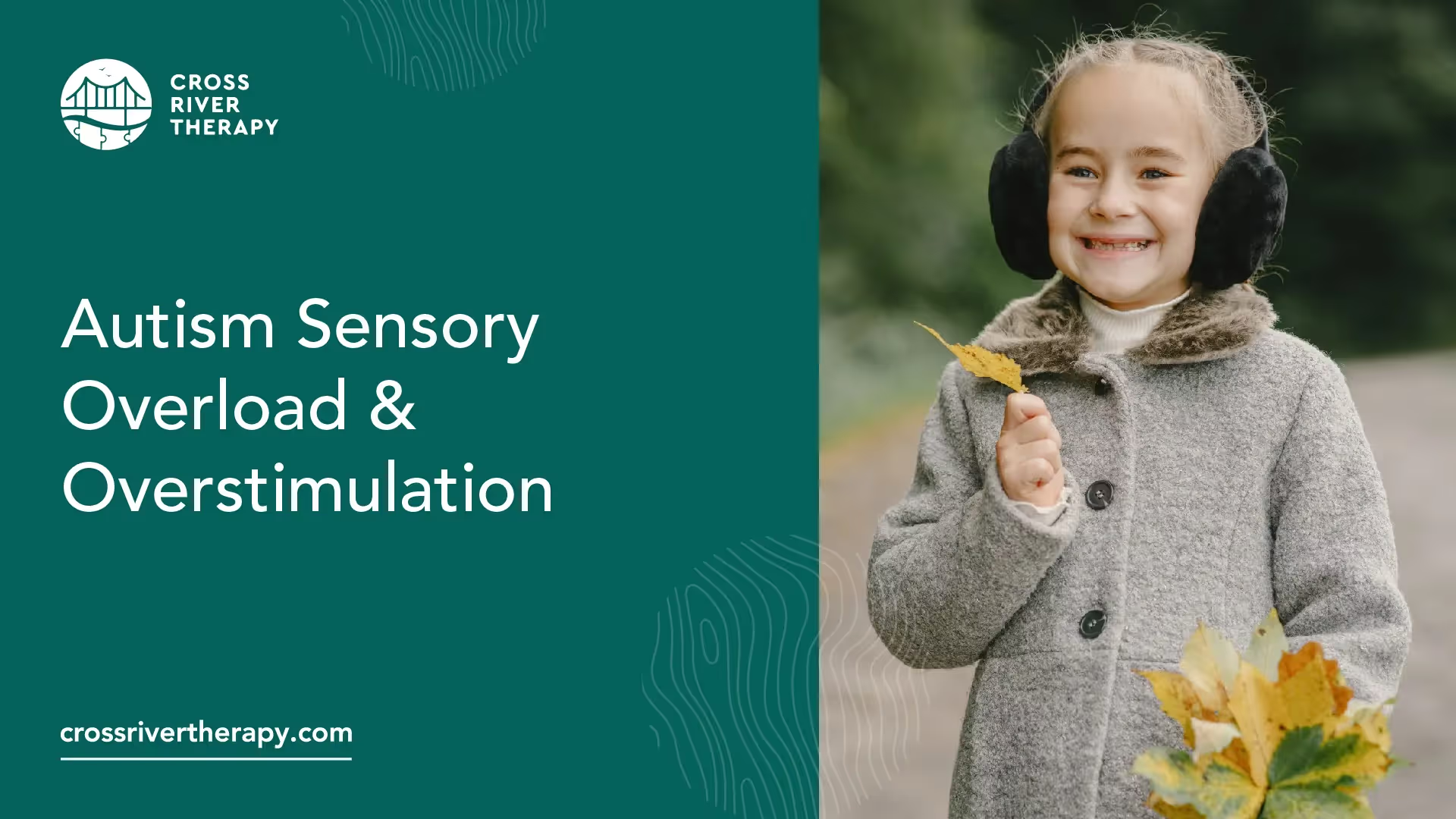Autism Sensory Overload & Overstimulation
Many children with autism are very sensitive to their environments and it can be challenging for them to filter out certain information that comes in.
What Are Sensory Issues?
Sensory issues are common in people with autism. They're even included in the diagnostic criteria for autism spectrum disorder. Each individual with autism is unique, nd this includes their personal sensory sensitivities.

Autism is a neurodevelopmental disorder that affects communication, behavior, and social interaction. One of the most common symptoms of ASD is sensory processing difficulties, which can lead to overstimulation.
People with autism can experience both hypersensitivity (over-responsiveness) and hyposensitivity (under-responsiveness) to a wide range of stimuli. Most individuals have a combination of both.
Common Sensitivities
- Sights
- Sounds
- Tastes
- Smells
- Balance
- Touch
- Awareness of body position and movement
- Awareness of internal body cues and sensations
What Do Sensory Issues Feel Like?
Sensory issues can be tough to put into words, especially for kids who might not have the right words to explain what they're feeling. But it's super important for parents and caregivers to get a handle on what sensory issues are like so they can help out.
For lots of folks with autism, sensory issues can be really intense and overwhelming. They might feel things that are painful or just plain uncomfortable, like a scratchy tag on their shirt or a loud noise. These sensations can be really hard to ignore and might make them feel all kinds of emotions.

Sensory issues can also cause anxiety and stress. Kids with autism might get worried about going to certain places or doing certain things because they know it'll be too much for them to handle.
It's super important for parents and caregivers to pay attention to their kid's signals and take their sensory needs seriously. By understanding what sensory issues feel like, parents and caregivers can work together with their child to make a safe and supportive environment that helps them feel good and avoid getting overwhelmed.
What Do Sensory Issues Look Like?
It's important to keep in mind that sensory issues can look different from person to person. Some children with autism may be sensitive to certain textures or sounds, while others may seek out certain sensations, like the feeling of pressure or vibration.
For example, a child who is sensitive to loud noises might cover their ears or become agitated when hearing a fire alarm. On the other hand, a child who seeks out tactile input might enjoy playing with slime or sand for extended periods of time.

In some cases, sensory issues can also impact a child's behavior and social interactions. For instance, a child who becomes overwhelmed by bright lights and crowded spaces might avoid going to birthday parties or other social events.
It's important for parents and caregivers to observe their child's behavior and work with them to identify any sensory triggers that may be causing distress. By understanding what sensory issues look like for their child, parents and caregivers can take steps to create a supportive environment that promotes well-being and reduces the risk of overstimulation.
When Does Overstimulation Occur?
Overstimulation/sensory overload occurs when a child's senses are overwhelmed by the environment, leading to distress and anxiety. It happens when someone's brain is getting more information from their senses than it can process.
Overstimulation can be triggered by a variety of factors, including loud noises, bright lights, strong smells, and tactile sensations. Children with ASD may have difficulty processing these stimuli, leading to a sensory overload that can be difficult to manage.
Fortunately, there are several strategies that parents and caregivers can use to help children with autism avoid overstimulation.
How To Avoid Overstimulation & Sensory Issues
Create a Sensory-Friendly Environment
One of the best ways to help children with autism avoid overstimulation is to create a sensory-friendly environment. This means reducing the amount of sensory input in the environment and providing a calm, predictable space for the child to relax.
Some tips for creating a sensory-friendly environment include:
- Reduce noise levels by using sound-absorbing materials, such as carpets and curtains.
- Dim the lights or use natural lighting to create a soothing atmosphere.
- Use calming colors, such as blues and greens, to create a peaceful environment.
- Provide a comfortable space for the child to relax, such as a beanbag chair or a soft rug.
Use Visual Schedules
Visual schedules can be a helpful tool for children with autism who struggle with transitions and changes in routine. A visual schedule is a series of pictures or symbols that represent the child's daily activities.
Using a visual schedule can help the child understand what is happening throughout the day and reduce anxiety about transitions. It can also help the child prepare for upcoming events and feel more in control of their environment.
Provide Sensory Breaks
Sensory breaks are short periods of time when the child can engage in calming activities to reduce overstimulation. Sensory breaks can be especially helpful during times of high stress, such as during a noisy event or after a long day at school.
Some examples of sensory breaks include:
- Deep pressure activities, such as squeezing a stress ball or wrapping the child in a weighted blanket.
- Calming activities, such as listening to music or taking a warm bath.
- Physical activities, such as jumping on a trampoline or going for a walk.
Use Social Stories
Social stories are short stories that help children with autism understand social situations and expectations. Social stories can be used to help children understand how to behave in different situations, such as going to the doctor or attending a party.
Using social stories can help reduce anxiety and increase the child's understanding of social cues. It can also help the child feel more confident in social situations and reduce the risk of overstimulation.
Understanding Autistic Overstimulation
Autistic overstimulation can be a challenging experience for both children and adults with Autism Spectrum Disorder (ASD). It is important to understand what overstimulation feels like in order to recognize and prevent it.
For individuals with ASD, overstimulation can feel like an overwhelming flood of sensory input. This can manifest in a variety of ways, including physical discomfort, anxiety, irritability, or even physical pain.
Some common signs of autistic overstimulation include:
- Covering ears or eyes
- Rocking back and forth or other repetitive behaviors
- Clenching fists or tensing muscles
- Becoming agitated or upset without an obvious cause
It's important to note that everyone experiences overstimulation differently. Some individuals may become more withdrawn and shut down while others may become more hyperactive or impulsive.
By understanding the signs of autistic overstimulation, parents and caregivers can work to create a sensory-friendly environment that reduces the risk of sensory overload for children with ASD.
FAQs
Do autistic people get sensory issues easily?
Autistic individuals are known for having a heightened sensitivity to sensory input, which means they may be more prone to overstimulation than neurotypical individuals. This can make it difficult for them to navigate certain environments, such as busy shopping malls or crowded social events.
It's important to note that not all autistic individuals experience overstimulation in the same way or to the same degree. Some may have a higher threshold for sensory input and be less easily overwhelmed, while others may become overstimulated even in relatively calm environments.
This is why it's crucial for parents and caregivers of autistic children to understand their individual needs and preferences when it comes to sensory input. By creating a personalized plan for managing overstimulation, parents and caregivers can help their children feel more comfortable and supported in their daily lives.
How common is autism overstimulation?
Autism overstimulation is a common experience for individuals with ASD. Research suggests that up to 70% of children with autism have sensory processing difficulties, which can lead to overstimulation and other sensory-related challenges.
It's important to note that while overstimulation is a common experience for individuals with autism, it can manifest in different ways and may vary in intensity from person to person. Some individuals may become overwhelmed by loud noises or bright lights, while others may struggle with tactile sensations or certain smells.
Parents and caregivers of autistic children should be aware of the potential for overstimulation and work to create a sensory-friendly environment that meets their child's unique needs. By understanding the signs of overstimulation and taking proactive steps to reduce sensory input, parents and caregivers can help their children feel more comfortable and supported in their daily lives.
Why does sensory overload happen?
Autism overstimulation occurs when the brain has difficulty processing sensory information from the environment. This can happen for a variety of reasons, including differences in brain structure and function.
Research suggests that individuals with autism may have differences in how their brains process sensory input. For example, some studies have found that individuals with autism may have more connections between different areas of the brain, which can lead to increased sensitivity to sensory input.
Additionally, individuals with autism may have differences in the way they filter out irrelevant sensory information. This means that they may become overwhelmed by stimuli that neurotypical individuals would find unnoticeable or easy to ignore.
It's important to note that while researchers are still exploring the underlying causes of autism overstimulation, it is clear that it is a common experience for many individuals with ASD. By understanding the factors that contribute to overstimulation, parents and caregivers can work to create a supportive environment that reduces sensory overload and promotes well-being for children with autism.
Conclusion
Sensory issues are a common challenge for children with autism, but there are many strategies that parents and caregivers can use to help their child avoid sensory overload.
By creating a sensory-friendly environment, using visual schedules, providing sensory breaks, and using social stories, parents and caregivers can help their child feel more comfortable and confident in their environment. With the right support, children with autism can thrive and reach their full potential.



